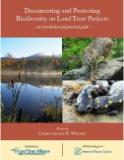Documenting and Protecting Biodiversity on Land Trust Projects
by Christopher R. Wilson
Are you a land trust worker who wants to incorporate biological information into your projects but are not sure how sure how to proceed?
Perhaps you are a biologist or consultant, who wants to help land trusts, but are not clear on what types of biological information land trusts need, how the data will be used, or how land trusts operate?
Maybe you're a landowner who wishes to place a conservation easement on your property, but are unsure of how biological information will help?
Documenting and Protecting Biodiversity on Land Trust Projects helps bridge these gaps between conservation science and its application to voluntary land protection.
The goal of the book is to help land trust practitioners and landowners understand what biodiversity is, how it's conserved, how the important biological attributes of a project are identified and documented, and how to translate this information into protection and management. It also helps biologists, consultants, and landowners understand the role and responsibilities of land trusts, what types of biological information are most useful, and how this information is applied to the land protection process.
The book reviews free data sources that allow land trusts to assess a wide range of biological attributes easily, quickly, and inexpensively at the very beginning of the land protection process, when such information is most useful. The use of on-the-ground biological inventories is also discussed, including what type of biologist to use, when such studies are recommended, what they should entail, and how to gain the most useful information for the least amount of time and money.
Finally, the book discusses biological reports and how they inform land trust activities, such as , fundraising, drafting conservation easement language, compiling baseline documentation, and writing management plans. The book also emphasizes how the biological analysis process can help land trust projects conform to Land Trust Standards and Practices, the Internal Revenue Code (IRC), and Internal Revenue Service (IRS) Treasury Regulations, and ultimately contribute to conserving biodiversity.
Visit the Land Trust Alliance bookstore for a sneak peak or to purchase your copy of the book or e-book today!
What the Experts Are Saying
"This book falls into that rare category of 'necessary.' For people concerned about preserving the fabric of this earth in a time of tempestuous change, Chris Wilson has provided a mandatory manual. It will do much good in the world."
—Bill McKibben, author of The End of Nature and Deep Economy, advisor to Northeast Wilderness Trust
“Everybody talks about saving nature. Here's your operating manual for getting the job done. It clearly explains how to assess biodiversity on a property, what it takes to maintain or restore it, where to find expert help at each stage, and why this all matters. Add solid advice on subjects from fundraising for projects to complying with regulations, and you have a book that belongs in every land trust office. The sooner, the better.”
—Douglas H. Chadwick, wildlife biologist, author of The Wolverine Way, and a founding board member of the conservation land trust Vital Ground.
“This book should serve as an important resource to land conservation practitioners hoping to maximize their conservation impact. It provides a concise introduction to many important facets of the rapidly changing world of biodiversity conservation; where information can be quite powerful, and bringing the right information to your decisions can make all the difference.”
—Pat Comer, Chief Ecologist, NatureServe
Go Straight to Your State
Learn about conservation and open space in your state.


